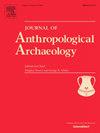波兰东北部钟烧杯陶器装饰的技术方面
IF 2.2
1区 社会学
Q1 ANTHROPOLOGY
引用次数: 0
摘要
陶器的装饰虽然对器皿的功能来说不是必不可少的,但却提供了了解过去社会的关键信息。除了美学之外,它还反映了技术技能、社会身份和文化互动。本研究考察了来自波兰东北部的贝尔烧杯陶器,该地区以其与西部贝尔烧杯群体的风格联系以及其在早期青铜时代发展中的作用而闻名。通过详细的宏观和微观概述,以及实验研究,它为陶工的技术能力和风格传统的功能提供了重要的见解,揭示了连续性和地方适应性。在这里,装饰是一种深思熟虑的、结构化的实践,嵌入在共同的认知框架中:由特定的“可见性制度”指导的心理模板。结果进一步表明,出现了一个当地的贝尔烧杯社区的做法,坚持更广泛的风格惯例,同时发展自己独特的方法。这些发现表明,陶器装饰可以成为追踪史前欧洲文化互动、知识交流和身份形成的有力工具。通过揭示这些动态,这项研究有助于全球讨论物质文化如何编码社会和技术信息,使其与欧洲史前专家和任何对思想和工艺传统的长期传播感兴趣的人相关。本文章由计算机程序翻译,如有差异,请以英文原文为准。
Technical aspects of Bell Beaker pottery decoration in North-Eastern Poland
Pottery decoration, though not essential for a vessel’s function, offers key insights into past societies. Beyond aesthetics, it reflects technological skill, social identity, and cultural interaction. This study examines Bell Beaker pottery from north-eastern Poland, a region notable for its stylistic ties to western Bell Beaker groups and its role in early Bronze Age developments. Through detailed macro- and microscopic overview, as well as experimental research, it provides critical insights into the technical abilities of potters and the functioning of stylistic traditions, revealing both continuity and local adaptation. Decoration emerges here as a deliberate, structured practice embedded in shared cognitive frameworks: mental templates guided by a specific ‘visibility regime’. The outcomes further suggest the emergence of a local Bell Beaker community of practice, which adhered to broader stylistic conventions, while simultaneously developing its own unique approach. These findings demonstrate that pottery decoration can be a powerful tool for tracing cultural interactions, knowledge exchange, and identity formation in prehistoric Europe. By shedding light on these dynamics, this research contributes to global discussions on how material culture encodes social and technological information, making it relevant to both European prehistory specialists and anyone interested in the long-term transmission of ideas and craft traditions.
求助全文
通过发布文献求助,成功后即可免费获取论文全文。
去求助
来源期刊

Journal of Anthropological Archaeology
Multiple-
CiteScore
4.00
自引率
11.10%
发文量
64
期刊介绍:
An innovative, international publication, the Journal of Anthropological Archaeology is devoted to the development of theory and, in a broad sense, methodology for the systematic and rigorous understanding of the organization, operation, and evolution of human societies. The discipline served by the journal is characterized by its goals and approach, not by geographical or temporal bounds. The data utilized or treated range from the earliest archaeological evidence for the emergence of human culture to historically documented societies and the contemporary observations of the ethnographer, ethnoarchaeologist, sociologist, or geographer. These subjects appear in the journal as examples of cultural organization, operation, and evolution, not as specific historical phenomena.
 求助内容:
求助内容: 应助结果提醒方式:
应助结果提醒方式:


